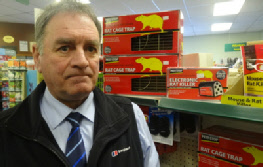
Scottish Natural Heritage (SNH) has denied that an increase of rats in the Western
Isles is due to the success of a mink cull.
Many islanders blame the near eradication of the predator has led to rats are breeding
like wildfire.
The vermin has caused serious damage to cars by chewing through wiring and leaving
dirt and smell behind.
But SNH points out that rat populations are determined by availability of food -
not be the lack of mink.
David Maclennan of SNH said: “We have had a lot of reports from people throughout
the islands about an increase in the rat population.
That’s obviously of concern to communities where that’s happening.
“However, we do not believe that’s relate dot the removal of mink from the Outer
Hebrides.
“That’s because rats have been living here for thousands of years. Their populations
have naturally flucated - some years there’s a lot, some there’s there’s not very
many of them.
Mr Maclennan said: “That fluctuation is driven by things like the weather, the amount
of food that’s available to rats, and the number of places that they can shelter.
“Even when the mink population was at its height in Lewis and Harris, that number
of mink would not have a significant impact on the number of rats. So we don’t believe
the removal of mink is responsible for the increase of rats.”
SNH highlighted that Barra also suffers from a rat problem yet mink were never present
there.
Regardless of the reasons, the islands are reporting a plague of rats in many districts.
Ian Fargie of Lewis Crofters said sales of rat control items have escalated.
Mr Fargie said: “The rat population seems to have grown in the last couple of years.
There has been a dramatic increase in sales of vermin control products.”
Mink first found its way into the islands’ environment in the 1960s and 70s, a refugee
from nearby fur farms.
Numbers of the escapees boomed and threatened the area’s biodiversity by eating nesting
wader birds’ eggs and preying on local wildlife.
Birds at serious risk are Arctic tern, common tern, little tern, black throated diver,
red throated diver, corncrake, dunlin and ringed plover.
In recent years 2,200 mink have been trapped and removed from Lewis and Harris and
Uist.

Islands suffering from a plague of rats 16/2/14
Iain Fargie of Lewis Crofters
Island shops are seeing a sales boom in rat control products.
